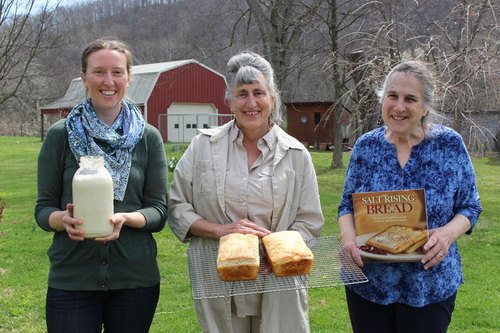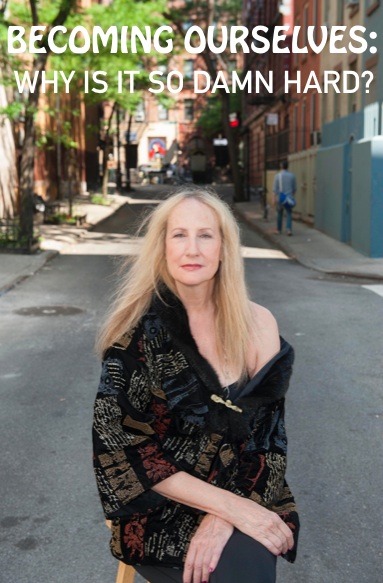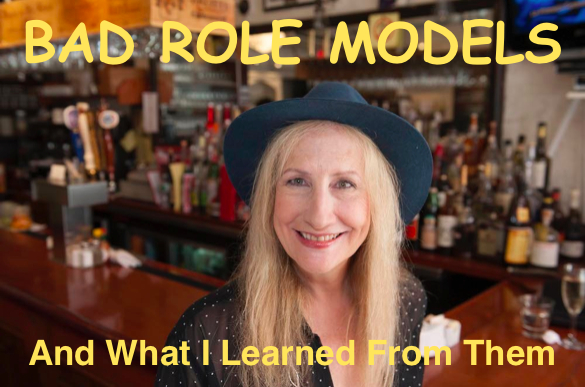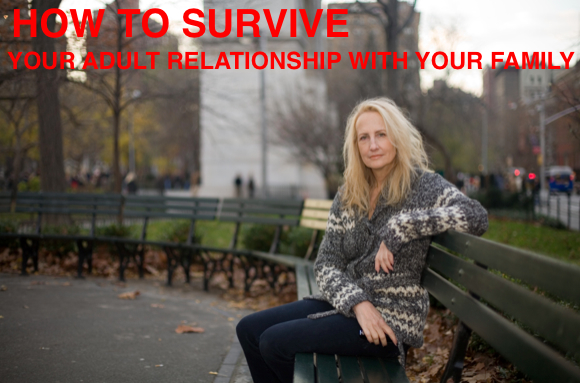IN PRAISE OF SALT-RISING BREAD
 Friday, June 22, 2018 at 04:21PM
Friday, June 22, 2018 at 04:21PM  Apprentice Amy Dawson and Salt-Rising Bread experts Genevieve Bardwell and Susan Brown.
Apprentice Amy Dawson and Salt-Rising Bread experts Genevieve Bardwell and Susan Brown.
I think most of us have memories of great bread we've eaten: crusty baguettes we dipped in sauces and soups, rye bread that made a perfect sandwich, or brioche that created the best French toast.
So I'm thrilled to interview Susan Brown, a charming and passionate baker who co-authored the cookbook "Salt-Rising Bread: Recipes and Heartfelt Stories of a Nearly Lost Appalachian Tradition." And just so you Gluten-Free readers know, the book also includes a way to make Salt-Rising Bread with a recipe just for you.
My own introduction to Salt-Rising Bread was recent. I'd been baking all of our bread for two years. However, I became intrigued with making Salt-Rising Bread when I was told about it by my late friend, Bill Stern, former food columnist for the LA Weekly (I wish they'd run an archive of his reviews) and now director of the Museum of California Design in Los Angeles. Even though Bill didn't grow up eating Salt-Rising Bread, he had great memories of eating it in Kentucky.
I'd never had Salt-Rising Bread, let alone heard of it. But when Bill said something like that, I'd take note. I had to find out more. I researched the internet about Salt-Rising Bread and found a recipe on the King Arthur website. There were warnings about making it. For one thing, it's tricky because it doesn't use yeast. It rises without yeast. And when the starter for it is really working, King Arthur said your place would smell like dirty socks.
Indeed, our place did smell like dirty socks. So it was working!
Yet, after the loaf was baked and cooled enough to slice into, the stinky sock smell was gone and that bread became deliciously cheesy. And it made the best toast that my husband and I had ever tasted.

I researched further. I discovered that Salt-Rising Bread had cult-like devotees. People talked about it the way Proust did about his madeleine. They searched long and hard for it, just so they could go back in time. What was it about Salt-Rising Bread that gave it this miraculous ability to inspire such loyalty?
I found the cookbook "Salt-Rising Bread" by Genevieve Bardwell and Susan Brown. (Bardwell owned Rising Creek Bakery in Mt. Morris, PA, where Salt-Rising Bread was a beloved fixture on the menu.) I read through it in a way I don't read through many other cookbooks. I was riveted -- and I was moved. I made a recipe for Salt-Rising Bread out of the book. Yes, it was stinky. Less stinky than the King Arthur Recipe, but still stinky. And delicious -- the toast was the best ever!
There's something about Salt-Rising Bread that's so personal you feel a connection with the people who make it. I found the website "Salt-Rising Bread Project" which Susan Brown runs and contacted her. She generously agreed to the following interview (and Salt-Rising Bread will be known as SRB):
Polly Frost: You write very passionately in your book about Salt-Rising Bread. Would you describe yourself as a passionate person in general or is there something specific about Salt-Rising Bread that you just love?
Susan Brown: I feel passionate about Salt-Rising Bread because of my grandmother, Katheryn Rippetoe Erwin. She made Salt-Rising Bread all of her life, as did her mother and her mother’s mother. I loved my grandmother, and I loved her Salt-Rising Bread. It is to Grandmother that I owe my appreciation for this bread, and to her that I attribute my commitment to carry on this family tradition in any way that I can. Whether it was for church bazaars, PTA bake sales, funeral dinners, ailing neighbors, or just “baking day,” Katheryn Erwin’s Salt-Rising Bread was famous in her hometown of Ronceverte, West Virginia. My memories of those early morning awakenings to check to see if her starter had come, and her wonderful breakfasts of fried bacon, eggs-over-easy, and Salt-Rising toast eaten at her kitchen table, stay with me and propel me year after year to keep the Salt-Rising Bread tradition alive. Although my grandmother is no longer with us, I never butter a slice of Salt-Rising toast without feeling her right there by my side.
PF: You mastered the quirky and temperamental art of making Salt-Rising Bread. Were you always a baker?
SB: I began baking at a very young age. I grew up in a large family, and cooking and baking were ways in which I could help my mother. In a family of many children, it was one way to get some positive approbation, which I think I yearned for.
PF: Can you tell me a bit about how Rising Creek Bakery came about?
SB: Two friends and I raised our daughters together in the same small community. During those years, we often talked about someday opening a bakery together in the town. In 2010, when the girls were out of school and had gone away to college, we opened Rising Creek Bakery. Only one of us owned it, and that was Genevieve ("Jenny") Bardwell. From the start, one of our most important goals for the bakery was to bake and sell SRB in an effort to help revive and keep alive this nearly forgotten Appalachian tradition. Jenny sold the bakery earlier this year, and the new owners hope to continue baking, selling, and shipping SRB. It was a fun ride, but definitely better suited for a younger generation than we have each become.
PF: In your book you discuss the question of the start of Salt-Rising Bread, and say that the exact origin of it remains a mystery. Do you think the mystery of its origin will ever be solved?
SB: Because eating SRB was a tradition for many generations on both my mother and father's sides of the family, I always assumed that this tradition was brought with them from their native Scotland, Ireland, and England. However, we have found no evidence of this bread ever having been made in those countries. Based on our research, Jenny and I conclude that SRB originated in the Appalachian mountain region in the early 1700s when yeast was not available for baking and when women, out of their own ingenuity, discovered by necessity how to make a risen loaf of bread for feeding their families. It is likely that they left a mixture of flour and milk, or flour and water, in a warm place (near an open hearth or by a fire used for cooking) for several hours or perhaps overnight and discovered it bubbled and rose after setting several hours. This led them to realize that they could make a risen bread this way.
PF: Most people reading this blog posting sadly will never have tasted Salt-Rising Bread, even those who buy bread from artisanal bakeries or make bread themselves. What would you say they're missing? And what is the home baker missing by not making it?
SB: People love bread for many reasons. With SRB, many, many people love it because they connect this bread with a memory of a loved one who made it for them. They also love it because it has a wonderful taste and can’t be beat for the best toast on the planet. People who haven’t tried SRB are missing out on enjoying this unique tasting bread. The home baker who doesn’t make SRB is missing out on the enjoyment and personal satisfaction received when giving friends and family this bread that happily fills their stomachs and warms their heart and soul.
PF: What do you think of the gluten-free thing?
SB: To tell you the truth, I don’t think much about this. It does seem to me to be a bit of a “food fad” right now, but I’m sure that, for some people, gluten is a problem for them. Mostly, I just feel sorry for them because they have to miss out on so many wonderful breads and other foods that contain gluten.
PF: How popular was SRB at its most popular?
SB: Salt-Rising Bread had its heyday from roughly the 1930s through the 1970s. This is mainly due to the work of a Kansas (and later Pittsburgh) scientist named Dr. Henry Kohman. In the late teens and mid-1920s, he studied the science of SRB and discovered the bacteria that grow in the starter that enables the starter to ferment. From this knowledge, he was able to make a dried starter and patented that recipe. He then sold it to bakeries all across the United States. With this commercial starter, bakeries were able to make SRB much more reliably than ever before, so it was made in many states. In the early 1980s, the manufacturers of this dried starter stopped selling it, which was the end of most bakeries making SRB. It was simply just too tough to do it without the boost and reliability of Kohman’s Salt-Rising Bread Yeast (even though it was not really a yeast).
PF: This is a great era for artisanal bakeries, wineries, beer making, old cocktails and fermentation. Young people are rediscovering old ways of making and growing food. Two young women bakers took over Rising Creek and are continuing the traditions of food. Are there other artisanal bakeries right now who are making SRB?
SB: Of course, I cannot know for sure who is out there making SRB in bakeries right now, but I am pretty confident that there aren’t many. Jenny and I believe that there is currently no bakery that makes and sells as much SRB as Rising Creek does. We are aware of a few small bakeries that make a handful of SRB weekly. It requires a tremendous amount of dedication, time, patience, and hard work to make SRB on a constant and reliable basis. Sadly, few people are willing to commit to an endeavor like that.
PF: How do you find young people who didn't grow up with it reacting to it on first taste?
SB: It has been my perception that newcomers to SRB have been pleasantly surprised at its good taste. It has been very gratifying to me and to Jenny to know that we have helped to pass on and to keep this tradition alive through our work at the bakery, through our book, and through the SRB classes that we teach throughout the year.
PF: I began making SRB right after we had a major fire and mudslide where we live in Montecito, CA. The air was full of toxins for months afterwards. Nonetheless, my SRB flourished! What do you make of that?
SB: First of all, let me say that I am so sorry to hear of the destruction and sadness that your area suffered. It is hard to imagine going through something like that. As for why your SRB flourished at that time, I dare say that it had anything to do with what was occurring with the disaster. SRB was first made and has historically been made by women who were enduring hard times. It has, itself, endured for a long time since its beginnings in our mountains some 300 years ago. History shows us that SRB has lasted and continues to last because women (and a few men) have persisted and not given up on it, even during the tough times, whether they be due to weather or personal circumstance.
PF: I’m hoping my blog readers will buy your book and start making SRB regularly! Do you have any advice for them?
SB: We tell perspective SRB bakers that when you make SRB you need to have patience and perseverance. It takes a long time to make, and it doesn’t always work, so you need to be willing to keep trying.
PF: What's the difference between making SRB with just cornmeal and making it with potatoes and cornmeal and do you think one is better?
SB: It is interesting that there are actually many recipes for making SRB. However, the one similarity that all recipes share is that every recipe will use at least flour, cornmeal, or potato in the starter. Beyond that, any differences in the recipe will not affect the bread in the end. Sometimes I think that I find the potato starter makes a little moister loaf, but that is not necessarily so. Certainly, the taste is not affected by the variance in the starter of cornmeal only or cornmeal and potatoes. The difference you will see when potatoes are added to a starter is in the way the successfully fermented starter looks. Typically, a potato starter will rise more than a cornmeal starter.
PF: I love the stories and photos of Salt-Rising Bread home bakers in your book. What did it involve for you to find them and how did they enrich your knowledge of it?
SB: I have lived around women who made SRB all of my life. No matter where I have lived in the hills of West Virginia, there have been women nearby who made SRB. When Jenny and I began writing the book, we actively sought out women who made SRB and arranged to visit them in their homes. Even though many of them were strangers to us, they never turned us away, and they were always very kind in sharing their knowledge and stories with us. Sometimes, the women we interviewed would tell us the names of other SRB bakers in their area, so we interviewed them, as well. West Virginia is a small state, so it was possible for us to travel all over the state to find these women and to learn all we could from talking and visiting with them. Indeed, this was one of the most fulfilling experiences we had in writing the book. Not only did they teach us so much about SRB, but they shared some wonderful stories and memories with us that we will never forget.
PF: What have been some of your favorite letters, emails and other feedback from readers? What do they ask, does it seem to work in every part?
SB: We often say that Salt-Rising Bread is food for the body as well as for the soul. In fact, almost everyone who has eaten Salt-Rising Bread has a story to tell about it. These stories loom large in the hearts of those who love the bread. They are, indeed, another reason why the Salt-Rising Bread tradition lives on in our Appalachian homes and why it is so important and so special to preserve this bread and the stories that help keep this tradition alive. I have received hundreds of emails and letters over the years from lovers of SRB. As well, Jenny has received many at the bakery. Mostly, they tell us about someone beloved to them who made SRB. Often, they retell stories of the past that include SRB in them. Some write to ask questions about how to make the bread or how to help them solve problems they are having making the bread. Here are a few of my favorite stories that you might enjoy:
"I grew up in Sacramento, CA and would visit my grandmother in Southern California when I was a kid. That would have been in the '60s. She had two huge avocado trees in her back yard (along with wonderful walnut and Meyer lemon trees). We would go to Van De Kamp Bakery in her area and would buy the Salt-Rising Bread. As kids, my sister and I were fascinated with the windmill logo that turned and was lit up. You could see it for miles. The bakery smelled wonderful but it was even better when we would toast the Salt-Rising Bread back at the house. It made the whole house "stink" and we referred to the toast as "stinky toast". We would mash wonderful, fresh avocados from my grandmother's trees onto the buttered, still-warm toasted bread for breakfast. A little salt on top. We always looked forward to this breakfast when we would visit my grandmother. We would also buy 4 or 5 loaves of the bread to bring back home to Sacramento, and we would put them in the freezer and use them sparingly. We loved the bread."
"I grew up in Spelter, WV, just north of Clarksburg on Rt 19 (where the zinc factory used to be). My grandmother baked this bread EVERY Saturday morning of her life. I don't think she ever bought bread. She would make several loaves and a couple of cookie sheets full of wonderful large buns. We lived next door, and she would call me over just before she took the bread out of the oven. I would race over and wait (usually impatiently) until the bread came out. Then I would take one of the buns and poke my finger into the middle and wiggle it around to hollow it out a bit. I would then put fresh, real butter and my daddy's homemade blackberry jelly down into the hot bread. It would melt, and I would sit and eat that bun with a glass of cold milk. I'm 50 years old and my granny has been gone for nearly 40 years. If I close my eyes and let myself go back in time, I can still smell that wonderful aroma as the bread was baking and still feel my finger burning from sticking it into the bread (you'd think I would have learned to use a knife or fork!!!!) and I can almost taste that wonderful treat. It's one of my most treasured memories of my grandmother, who was my favorite person in the world!"
"Some of the best memories I have of home revolved around Salt-Rising Bread (it was "Ketterings"). Whenever both my sister and I could make it home to Clarksburg, WV, at the same time, Sunday morning was Salt-Rising Toast Time. We'd have Ma's brewed, sweetened ice tea and all the Salt-Rising toast we could eat. We'd always buy 2-3 loaves so we'd be sure there was enough toast to go around because Daddy liked it, too. We'd all sit around the table or on the floor by the table and read the Sunday paper and have our toast. Our Saint Bernard, Benjamin, even got a piece or two! Ma and Daddems are gone now. My sister lives in South Carolina, and I live in Texas. I have no doubt that the toast you send will be wonderful, but the memories that I'll have with that toast will be even better."
"I am ninety years old and have very fond memories of salt '"risen"bread. As a preteen, I spent most of my summers with my widowed grandmother and her niece on the farm. Thursday was baking day and Wednesday night "cousin Mag" prepared the starter from I don't know what except there was a potato and meal and possibly some milk. The meal was our own, having been ground from our corn at a local mill. The starter was placed in the warming oven of an old wood burning stove, and how they kept the temperature up during the night I don't know, but it worked. Thursday the baking began, and we had fresh bread with homemade butter and homemade jam that day and for a few days longer."



Reader Comments (7)
My mouth is watering. I want to try this sometime. Wonderful post!
Polly,
Polly, Thank you so very much for this valuable service to the culinary history of the United States.
BTW: Did I tell you about deep-fried corn on the cob?
I encountered that national treasure in Tulsa, Oklahoma.
On the other hand, I'm not going to tell you about St. Louis' pride and joy: fried ravioli.
Your devoted fan, Bill Stern
P.S. Will you next be making real, high-gluten bagels? I can't find them anywhere. If you do, I'll be the first customer for a baker's dozen of Polly-the Echt-Bagel-Baker's first product.
Thanks Joe and Bill! Yes, Bill, I have made hi-gluten bagels. In fact, the very thought of gluten-free bagels makes me think that they would be best served with salmon-free lox.
And no, Bill, you didn't tell me about deep-fried corn on the cob. Is it accompanied with a deep fried Twinkie for dessert?
Polly, great blog and fascinating stories of SRB. They rekindled memories of my grandmother Moore who made SRB. She decended from early American Revolutionary days in the 1770’s. Their Morgan horse ranch and home was in Abbs Valley, Virginia, now West Virginia. Stories passed down for generations included bread that did not need yeast was regularly baked,
Grandmother made it for family and friends but could not give specifics on her recipe. Things like “Make starter and later add flour and knead till it looks right” No measurements!
My mom could not figure out how to even begin. Lost recipe until Sweet Polly gave me a precious loaf she had just baked and told me about the book which provided a sane recipe I could understand.
I can hear my Abbs Valley Virginia ancestors cheering as I bake my first loaf of Salt Rising Bread, my sincere thanksgiving!
Thank you, Barbara! I look forward to hearing about your Salt-Rising Bread!